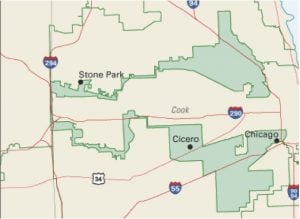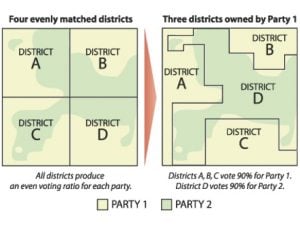
With the November midterm elections beckoning, concerns are arising as to how the decisions of voters may be challenged via the constantly increasing effects of political gerrymandering.
Gerrymandering, or the redistricting of voter districts for political purposes, occurs because state legislatures are allowed to draw new districts after the census, which occurs every 10 years. The ruling party has generally used these opportunities to its advantage, redrawing lines so that strong populations of opposition voters are weakened.
Areas of opposition are either split and districted with previously separate populations that may support the status quo, or concentrated into single districts as to eliminate competitiveness in other neighboring districts.
The potential ramifications for the upcoming elections are real. The Washington Post claimed that only 30 House races are competitive; in all other races, the incumbent or front-running candidate is calculated as having at least a 90 percent chance of winning a seat.
According to an analysis by Christopher Ingraham of The Washington Post, gerrymandering was responsible for an additional 18 Republican seats in the House elections of 2012, based on comparisons between the popular vote and the actual representation different parties received in Congress. That year, House Democrats received 50.6 percent of the popular vote nationwide, but only 46.21 percent of total House seats, thus preserving a Republican House majority that had very real ramifications in the passing of policies between Congress and the Obama administration.
Based on polls and historical voting trends, analysts at Politico said if the upcoming elections were hosted on Oct. 1, the Republican House majority would likely widen by an additional eight seats.

Democrats have also been guilty of heavy redistricting, as Republican candidates in Illinois have discovered. Illinois Congressional redistricting occurred in 2011 and helped lead Democrats claim 12 of 18 House seats in 2012 elections, despite only winning 55 percent of the popular vote.
Critics of the practice claim that it is unethical on a number of fundamental criteria. In addition to the previously mentioned viewpoints, gerrymandering often concentrates and politically under-represents minorities. Some critics also said gerrymandered districts may simply fail to make geographical sense in accordance to actual community boundaries.
“A beautiful electoral district is in the eyes of the beholder,” Larry Bennett, a DePaul political science professor, said. “A problem is that there’s no standard for what an ‘ethically districted’ area looks like.”
There have been various attempts to stymie practices of gerrymandering. On Oct. 7, U.S. district courts declared Virginia’s gerrymandered 3rd Congressional District unconstitutional on the grounds of racial discrimination.
Similarly, in 2011 California established a Citizen’s Redistricting Commission, taking the power of political districting out of the hands of elected officials.
However, large-scale pushes for these types of practices have not been stringent. Except in cases of extreme racial discrimination, there is often little legal basis for striking down the practice. Furthermore, ruling politicians are, understandably, often unwilling to give up their power over districting.
“With (citizens commissions), there’s also the issue that their members can potentially be ideologically compromised as well,” Bennett said.
Without any large pushes to end gerrymandering, it remains to be seen how the practice may influence the November elections.
“I don’t think there are really any ethical validations of gerrymandering,” Bennett said.


Boyee • Oct 14, 2014 at 5:29 pm
Lincoln Park got gerrymandered very much. It will go from being 2 wards (43rd and 32nd) to 3 soon with a few blocks north of North Avenue put into the ward of the Near North Side area south of North Avenue. The Latino Caucus had by far the most reasonable plan and kept Lincoln Park in 2 wards. But the Black Caucus map won, splitting Lincoln Park into 3 wards (2nd, 32nd, and 43rd) despite the Latino population in Chicago going up and the Black population in Chicago shrinking.